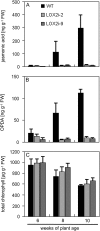Differential impact of lipoxygenase 2 and jasmonates on natural and stress-induced senescence in Arabidopsis
- PMID: 20190093
- PMCID: PMC2850018
- DOI: 10.1104/pp.110.153114
Differential impact of lipoxygenase 2 and jasmonates on natural and stress-induced senescence in Arabidopsis
Abstract
Jasmonic acid and related oxylipins are controversially discussed to be involved in regulating the initiation and progression of leaf senescence. To this end, we analyzed profiles of free and esterified oxylipins during natural senescence and upon induction of senescence-like phenotypes by dark treatment and flotation on sorbitol in Arabidopsis (Arabidopsis thaliana). Jasmonic acid and free 12-oxo-phytodienoic acid increased during all three processes, with the strongest increase of jasmonic acid after dark treatment. Arabidopside content only increased considerably in response to sorbitol treatment. Monogalactosyldiacylglycerols and digalactosyldiacylglycerols decreased during these treatments and aging. Lipoxygenase 2-RNA interference (RNAi) plants were generated, which constitutively produce jasmonic acid and 12-oxo-phytodienoic acid but do not exhibit accumulation during natural senescence or upon stress treatment. Chlorophyll loss during aging and upon dark incubation was not altered, suggesting that these oxylipins are not involved in these processes. In contrast, lipoxygenase 2-RNAi lines and the allene oxid synthase-deficient mutant dde2 were less sensitive to sorbitol than the wild type, indicating that oxylipins contribute to the response to sorbitol stress.
Figures





Similar articles
-
Evidence supporting a role of jasmonic acid in Arabidopsis leaf senescence.Plant Physiol. 2002 Mar;128(3):876-84. doi: 10.1104/pp.010843. Plant Physiol. 2002. PMID: 11891244 Free PMC article.
-
Lipoxygenase6-dependent oxylipin synthesis in roots is required for abiotic and biotic stress resistance of Arabidopsis.Plant Physiol. 2013 Apr;161(4):2159-70. doi: 10.1104/pp.113.214544. Epub 2013 Feb 26. Plant Physiol. 2013. PMID: 23444343 Free PMC article.
-
Axial and Radial Oxylipin Transport.Plant Physiol. 2015 Nov;169(3):2244-54. doi: 10.1104/pp.15.01104. Epub 2015 Sep 3. Plant Physiol. 2015. PMID: 26338953 Free PMC article.
-
The squeeze cell hypothesis for the activation of jasmonate synthesis in response to wounding.New Phytol. 2014 Oct;204(2):282-8. doi: 10.1111/nph.12897. New Phytol. 2014. PMID: 25453132 Review.
-
Plant oxylipins: role of jasmonic acid during programmed cell death, defence and leaf senescence.FEBS J. 2009 Sep;276(17):4666-81. doi: 10.1111/j.1742-4658.2009.07193.x. Epub 2009 Aug 3. FEBS J. 2009. PMID: 19663906 Review.
Cited by
-
Pheophorbide a May Regulate Jasmonate Signaling during Dark-Induced Senescence.Plant Physiol. 2020 Feb;182(2):776-791. doi: 10.1104/pp.19.01115. Epub 2019 Nov 21. Plant Physiol. 2020. PMID: 31753845 Free PMC article.
-
Oxylipins and Reactive Carbonyls as Regulators of the Plant Redox and Reactive Oxygen Species Network under Stress.Antioxidants (Basel). 2023 Mar 27;12(4):814. doi: 10.3390/antiox12040814. Antioxidants (Basel). 2023. PMID: 37107189 Free PMC article. Review.
-
CmLOX10 positively regulates drought tolerance through jasmonic acid -mediated stomatal closure in oriental melon (Cucumis melo var. makuwa Makino).Sci Rep. 2020 Oct 15;10(1):17452. doi: 10.1038/s41598-020-74550-7. Sci Rep. 2020. PMID: 33060707 Free PMC article.
-
Epigenetic control of plant senescence and cell death and its application in crop improvement.Front Plant Sci. 2023 Oct 30;14:1258487. doi: 10.3389/fpls.2023.1258487. eCollection 2023. Front Plant Sci. 2023. PMID: 37965008 Free PMC article. Review.
-
Lipid profiling of the Arabidopsis hypersensitive response reveals specific lipid peroxidation and fragmentation processes: biogenesis of pimelic and azelaic acid.Plant Physiol. 2012 Sep;160(1):365-78. doi: 10.1104/pp.112.202846. Epub 2012 Jul 22. Plant Physiol. 2012. PMID: 22822212 Free PMC article.
References
-
- An YQ, McDowell JM, Huang S, McKinney EC, Chambliss S, Meagher RB. (1996) Strong, constitutive expression of the Arabidopsis ACT2/ACT8 actin subclass in vegetative tissues. Plant J 10: 107–121 - PubMed
-
- Balbi V, Devoto A. (2008) Jasmonate signalling network in Arabidopsis thaliana: crucial regulatory nodes and new physiological scenarios. New Phytol 177: 301–318 - PubMed
-
- Berger S, Weichert H, Porzel A, Wasternack C, Kuhn H, Feussner I. (2001) Enzymatic and non-enzymatic lipid peroxidation in leaf development. Biochim Biophys Acta 1533: 266–276 - PubMed
Publication types
MeSH terms
Substances
LinkOut - more resources
Full Text Sources
Molecular Biology Databases

